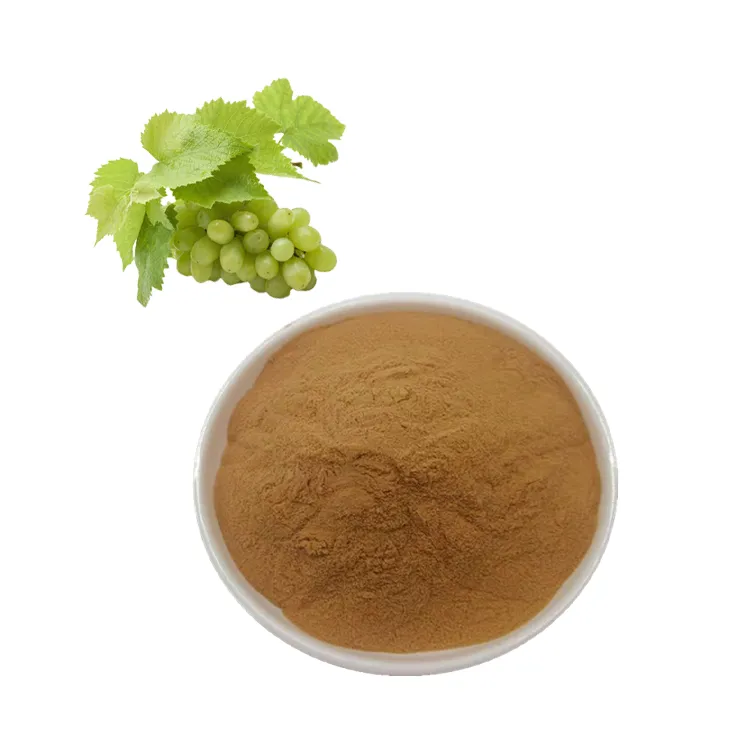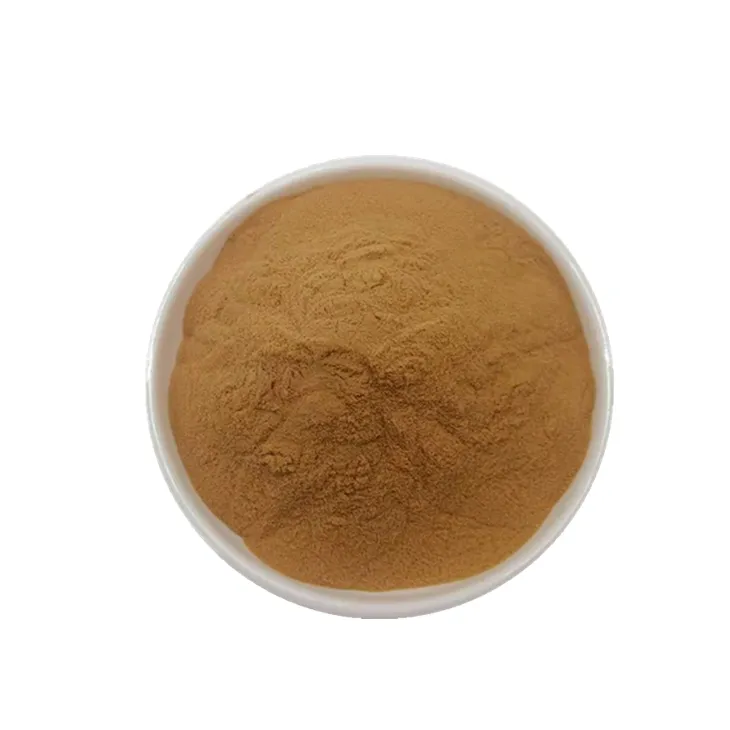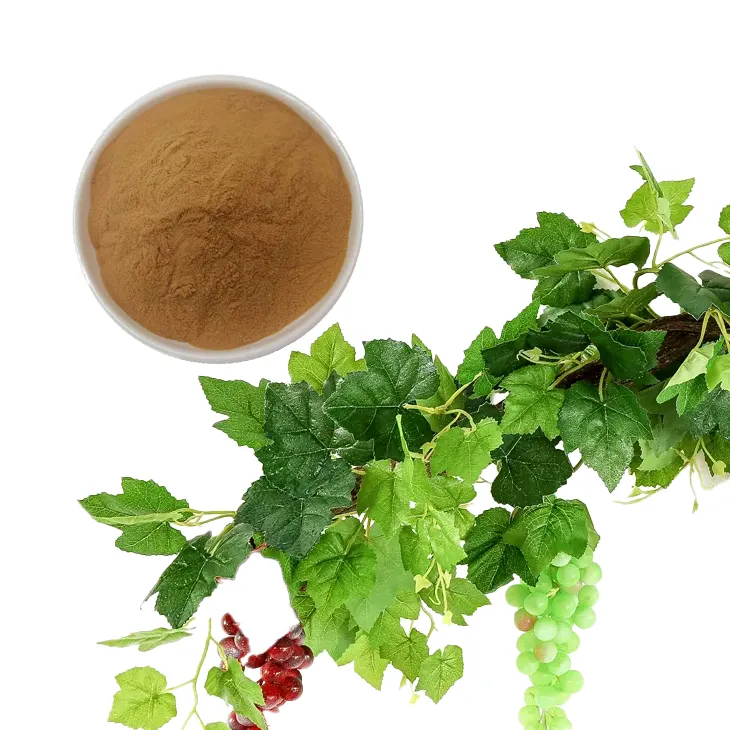- 0086-571-85302990
- sales@greenskybio.com
The Wonders of Grape Leaf Extract: A Journey from Vine to Health
2024-07-04

Introduction
Grape Leaf Extract has emerged as a remarkable natural substance in the realm of health and wellness. It is derived from the leaves of the grape vine, which has been cultivated for centuries for its fruit - grapes. However, the leaves themselves hold a treasure trove of beneficial compounds that are now being recognized for their potential to enhance human health.

The Source: The Grape Vine
The grape vine, Vitis vinifera being one of the most common species, is a plant with a long and rich history. It has been an important part of agriculture in many regions around the world. Grapes are used to make wine, juice, and are consumed as fresh fruits. The leaves of the grape vine, which are often overlooked in comparison to the fruit, are now coming into the spotlight for their health - promoting properties.

Resveratrol: The Star Compound
One of the most significant components in Grape Leaf Extract is resveratrol. Resveratrol is a polyphenol and a powerful antioxidant. It has been the subject of numerous scientific studies in recent years due to its potential health benefits.
Resveratrol and Longevity
There is evidence to suggest that resveratrol may be associated with longevity. In some animal studies, resveratrol has been shown to mimic the effects of calorie restriction, which is known to extend lifespan in various organisms. While more research is needed to fully understand the relationship between resveratrol and human longevity, the initial findings are quite promising.
Effects on the Immune System
Resveratrol in Grape Leaf Extract can have a positive impact on the immune system. It helps to boost the immune system by enhancing the function of immune cells. For example, it can increase the activity of macrophages, which are cells that play a crucial role in engulfing and destroying pathogens. This means that the body is better equipped to fend off infections, whether they are caused by bacteria, viruses, or other microorganisms.
Role in Cardiovascular Health
Another important aspect of resveratrol's benefits is its role in maintaining healthy blood vessels. It helps to keep the blood vessels flexible and elastic, which is crucial for proper blood flow. By reducing the inflammation in the blood vessels and preventing the build - up of plaque, resveratrol can significantly reduce the risk of cardiovascular diseases such as heart attacks and strokes.
- Resveratrol can lower blood pressure. High blood pressure is a major risk factor for cardiovascular problems, and by reducing it, resveratrol helps to keep the heart healthy.
- It also improves lipid profiles. This means that it can help to regulate cholesterol levels, reducing the levels of "bad" cholesterol (LDL) and increasing the levels of "good" cholesterol (HDL).
Impact on Cognitive Health
Resveratrol has been found to have a positive impact on cognitive health. It may help to improve memory and concentration. Some studies suggest that it can protect the brain from oxidative stress and inflammation, which are two factors that can contribute to cognitive decline. In addition, resveratrol may also play a role in promoting the growth of new neurons in the brain, which is important for maintaining cognitive function as we age.

Other Health Benefits of Grape Leaf Extract
While resveratrol is a major player, grape leaf extract offers other health benefits as well.
Antioxidant Activity
In addition to resveratrol, grape leaf extract contains other antioxidants. These antioxidants work together to scavenge free radicals in the body. Free radicals are unstable molecules that can cause damage to cells, DNA, and proteins. By neutralizing these free radicals, the antioxidants in grape leaf extract help to protect the body from various diseases, including cancer, neurodegenerative diseases, and age - related macular degeneration.
Anti - inflammatory Properties
Grape leaf extract has anti - inflammatory properties. Chronic inflammation is associated with many health problems, such as arthritis, diabetes, and heart disease. The anti - inflammatory compounds in grape leaf extract can help to reduce inflammation in the body, thereby alleviating the symptoms of these diseases and potentially preventing their progression.
Digestive Health
Grape leaf extract may also be beneficial for digestive health. It can help to soothe the digestive tract and reduce symptoms such as indigestion, bloating, and stomach cramps. Some studies suggest that it may also have a prebiotic effect, promoting the growth of beneficial gut bacteria, which are essential for a healthy digestive system.
How to Incorporate Grape Leaf Extract into Your Diet
If you are interested in reaping the health benefits of grape leaf extract, there are several ways to incorporate it into your diet.
Supplements
One of the easiest ways is to take grape leaf extract supplements. These are available in various forms, such as capsules, tablets, and liquid extracts. When choosing a supplement, it is important to look for a high - quality product from a reputable manufacturer. Check the label for the concentration of resveratrol and other active ingredients.
Food Sources
You can also get grape leaf extract from certain foods. In some Mediterranean and Middle Eastern cuisines, grape leaves are used in cooking. For example, stuffed grape leaves (dolma in Turkish cuisine) are a popular dish. Eating these foods can provide you with a natural source of grape leaf extract. However, it should be noted that the amount of extract obtained from food may be relatively small compared to taking supplements.
Conclusion
Grape leaf extract is a natural wonder with a wide range of health benefits. From its key component resveratrol, which is associated with longevity and has positive effects on various body systems, to its other antioxidant, anti - inflammatory, and digestive health - promoting properties, it offers a lot to those who are looking to improve their health. Whether through supplements or incorporating grape - leaf - containing foods into your diet, grape leaf extract can be a valuable addition to a healthy lifestyle.
FAQ:
What is grape leaf extract?
Grape leaf extract is a substance derived from the grape vine. It contains various beneficial components, with resveratrol being one of the most notable. It has been associated with multiple health benefits.
What are the main health benefits of grape leaf extract?
It has several health benefits. It contains resveratrol which is associated with longevity. It can enhance the immune system function, help maintain healthy blood vessels reducing cardiovascular disease risk, and also has a positive impact on cognitive health such as potentially improving memory and concentration.
How does grape leaf extract enhance the immune system?
The resveratrol in grape leaf extract is thought to play a role in enhancing the immune system. It helps the body to be more effective in fending off infections, although the exact mechanisms are still being studied.
Can grape leaf extract really reduce the risk of cardiovascular diseases?
Yes, it can. Grape leaf extract has a role in maintaining healthy blood vessels. By doing so, it can contribute to reducing the risk of cardiovascular diseases. However, it should be noted that it is usually part of a comprehensive approach to health and not a sole solution.
How does grape leaf extract affect cognitive health?
Grape leaf extract has been found to have a positive impact on cognitive health. It may improve memory and concentration, though the specific biological processes involved are still under research.
Related literature
- The Health Benefits of Grape Leaf Extract: A Comprehensive Review"
- "Resveratrol in Grape Leaf Extract: Implications for Health and Longevity"
- "Grape Leaf Extract and Cardiovascular Health: Current Research Findings"
- ▶ Hesperidin
- ▶ citrus bioflavonoids
- ▶ plant extract
- ▶ lycopene
- ▶ Diosmin
- ▶ Grape seed extract
- ▶ Sea buckthorn Juice Powder
- ▶ Beetroot powder
- ▶ Hops Extract
- ▶ Artichoke Extract
- ▶ Reishi mushroom extract
- ▶ Astaxanthin
- ▶ Green Tea Extract
- ▶ Curcumin Extract
- ▶ Horse Chestnut Extract
- ▶ Other Problems
- ▶ Boswellia Serrata Extract
- ▶ Resveratrol Extract
- ▶ Marigold Extract
- ▶ Grape Leaf Extract
- ▶ blog3
- ▶ blog4
- ▶ blog5
-
Dan Shen Root Extract/Salvia Root Extract
2024-07-04
-
Eucommia Ulmoides Extract
2024-07-04
-
Rosemary extract
2024-07-04
-
Panax Ginseng Leaf Extract
2024-07-04
-
Mulberry leaf Extract
2024-07-04
-
Boswellia Serrata Extract
2024-07-04
-
Ginger Extract
2024-07-04
-
Chaste Berry Extract
2024-07-04
-
Sophora Flavescens Root Extract
2024-07-04
-
Troxerutin
2024-07-04





















